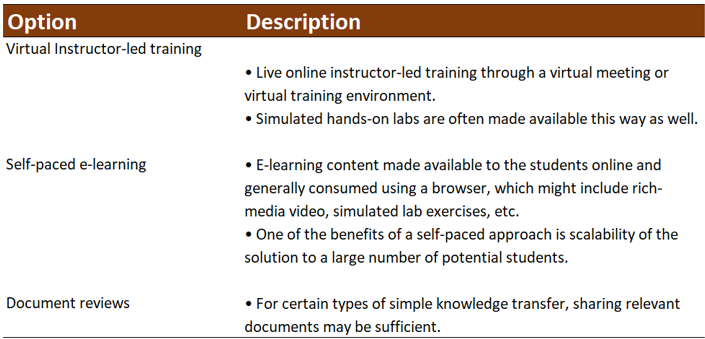Train team members and stakeholders
Enablers
- Determine required competencies and elements of training. (ECO 1.5.1)
- Determine training options based on training needs. (ECO 1.5.2)
- Allocate resources for training. (ECO 1.5.3)
- Ensure training occurs.
- Measure training outcomes. (ECO 1.5.4)
Deliverables, and Tools

Required Competencies
- Identifying the required competencies is the first aspect of developing and executing a training plan.
- Competencies can include knowledge, skills, and other attributes.
- Different stakeholders will have different training needs.
- Team members themselves may require specific training on the customer’s business, culture, desired outcomes, and the project’s context.
Elements of Training
Training is an activity in which team members acquire new or enhanced skills, knowledge, or attitudes.
Provided to teams, small groups, individuals
Covers management, technical, or administrative topics
Delivery models might include:
- Instructor-led classroom
- Virtual classroom
- Self-paced e-learning
- Document reviews
- Interactive simulations
- On-the-job training
Guidelines to Determine Required Competencies
- What knowledge will be required for this stakeholder to perform as expected with the new solution?
- What skills or hands-on experience are needed to learn and be able to demonstrate readiness to carry out work using the solution?
- What level of buy-in to the solution has been given by the stakeholder, and what aspects of the training need to be employed to help develop support for the solution?
- What modalities of training should be offered, and what are the relative costs of different approaches?
Training and Mentoring Plan
- Training should be done as close to the point of solution use as possible.
- Scheduling is critical to avoid delaying the overall solution deployment.
- Perform a gap analysis to identify missing knowledge, skills, or required attributes.
- A training plan for team members can include improvement in competencies or possibly certification to benefit the project.
Training Options

Training Cost Estimates
Costs associated with training project staff and customer stakeholders should be taken into account as part of the overall schedule and budget for the project.
These costs may include:
- Content creation and editing costs
- Content hosting and delivery costs
- Instructional costs
- Courseware printing and distribution
- Venue costs (including potential use of equipment)
- Logistics costs (A/V, lunch, etc.)
Training Calendar
- Project manager needs to publish and support a specific calendar of training dates and locations.
- Schedule also needs to be published to the customer stakeholders.
- Create a mechanism for registration and sending confirmation messages.
- Provide class rosters and a way to capture signatures of attendees.
- Manage the training schedule and timing to avoid delaying the project’s delivery timeline.
Pairing and Mentoring
- Pairing customer stakeholders together enables them to reinforce the learning in each other.
- Mentoring enables an experienced team member to coach a less experienced team member.
- Pairing and mentoring foster team building and a collaborative environment.
- Training focuses on building individual skills to be used in the present.
- Mentoring helps develop well-rounded individuals for the future through long-term professional relationships between novice and experienced employees.
- Relationships can be informal, ad-hoc ones created by the individuals themselves, or might be formally established by the organization, who intentionally pair the participants.
Baseline and Post-Training Assessments
- Baselining provides a technique for measuring the efficacy of training.
- Attendees complete a pre-assessment before training.
- After training, a post-assessment is used to demonstrate the newly acquired levels of competence.
Guidelines to Ensure Training Occurs
- Create awareness among the stakeholders about available training.
- Be sure to create invitations to attend the training.
- Engage with customer management to obtain their buy-in and commitment for their employees to attend the training programs.
- When people register to attend the training, they should receive a registration confirmation notice and a reminder prior to the training event to ensure they have not forgotten.
- Rosters should be created for each delivery of the training, and signatures captured to confirm attendance and participation in any pre- or post-assessments.
Certifications
Industry certifications demonstrate that knowledge and skills have been gained during training.
The location and administration of certification exams can vary:
- Delivered directly after the training class.
- Administered at a testing center with a proctor.
- Delivered online using a webcam proctor.
Industry credentials are more portable and can be more desirable by those who hold the certification and future employers.
Measure Training Outcomes
- Training is ultimately measured by the ability to perform the work needed.
- Post-assessments and certifications prove knowledge.
- The true test of training is demonstrated by applying the knowledge and skills at the workplace.